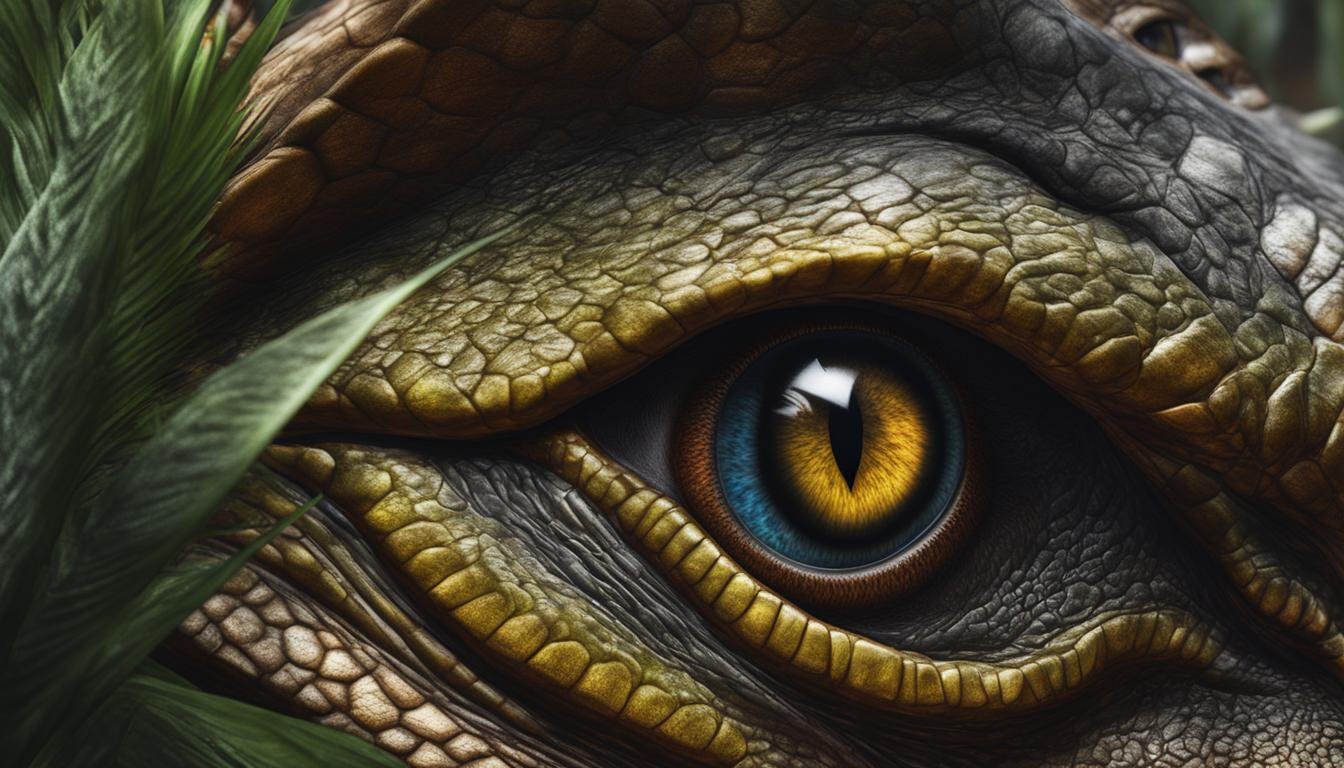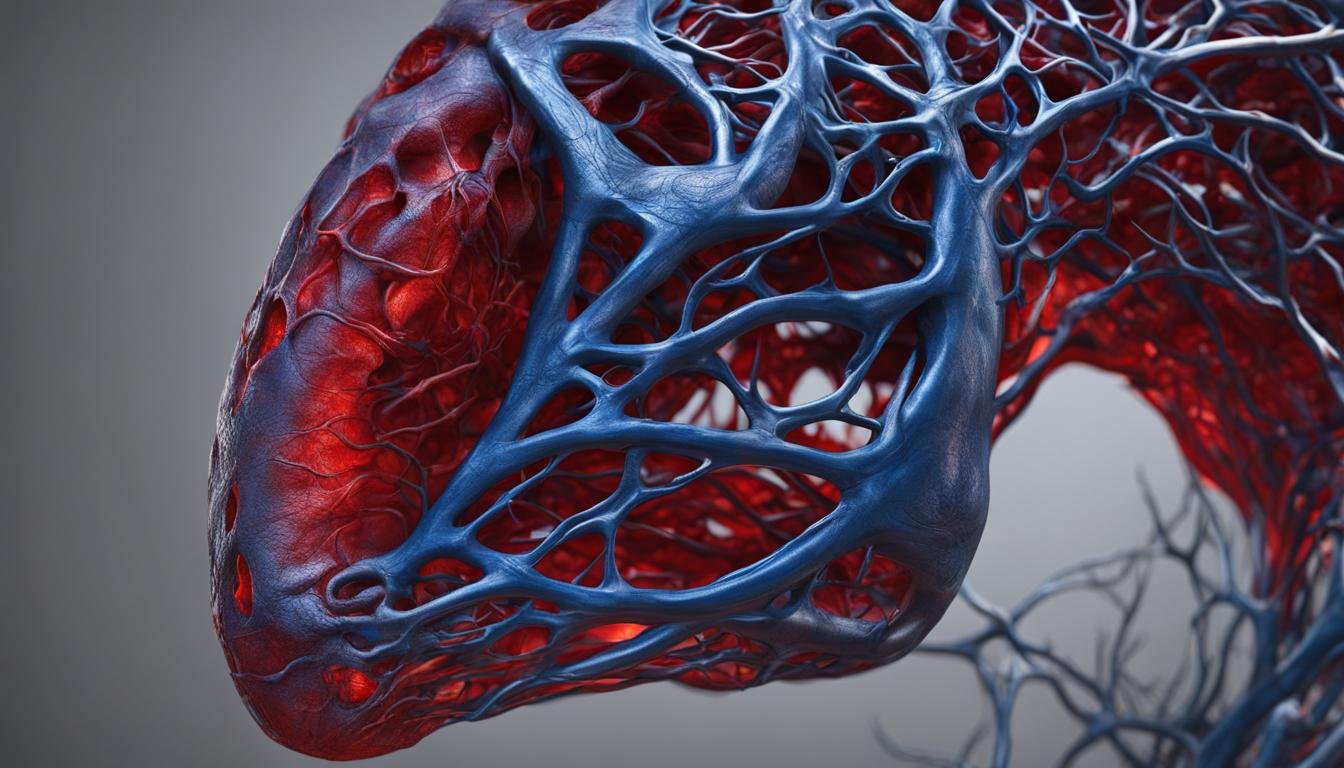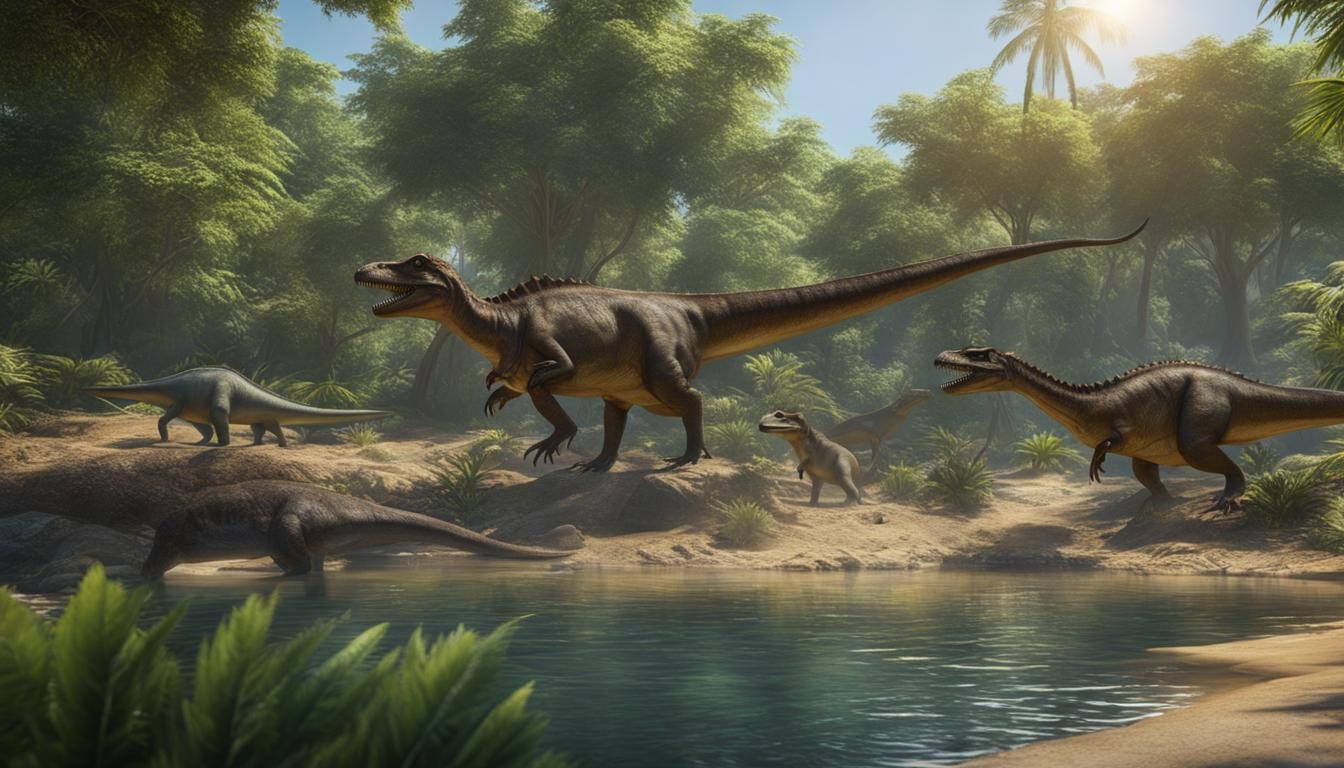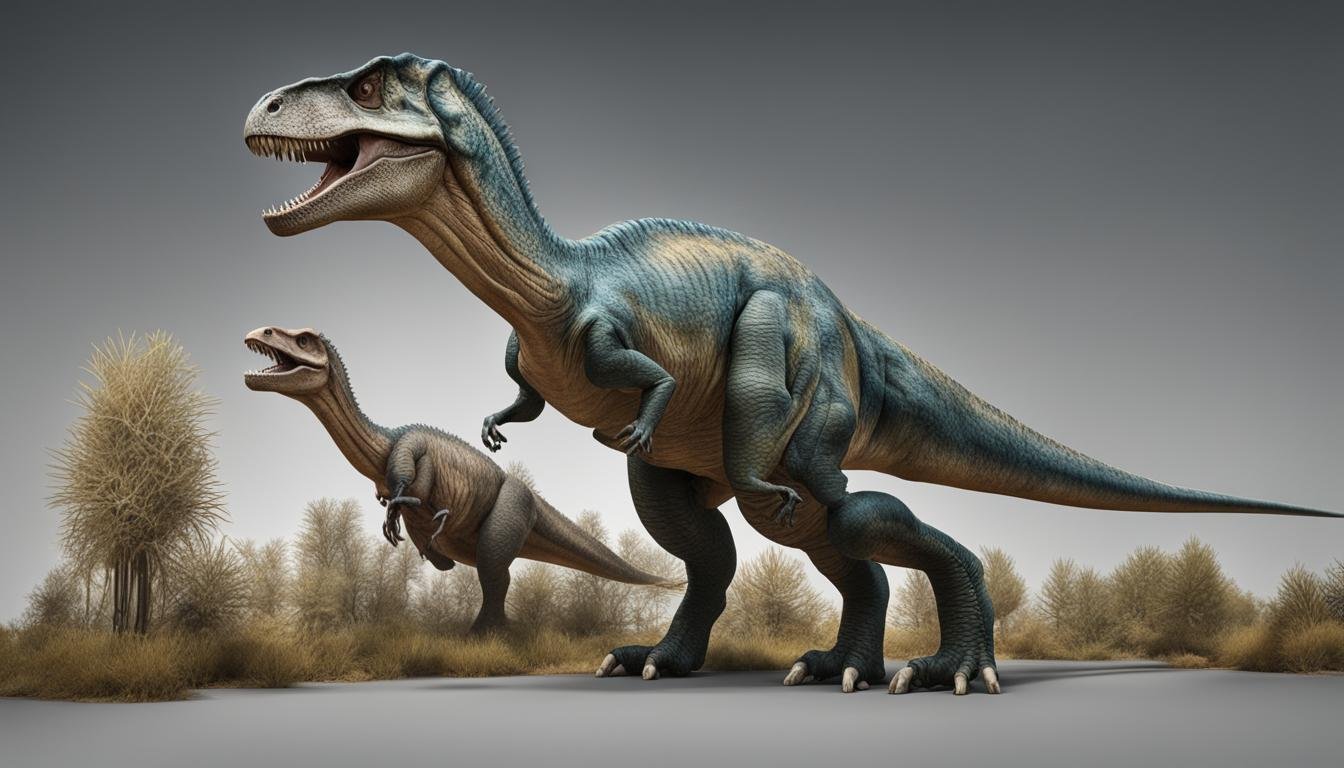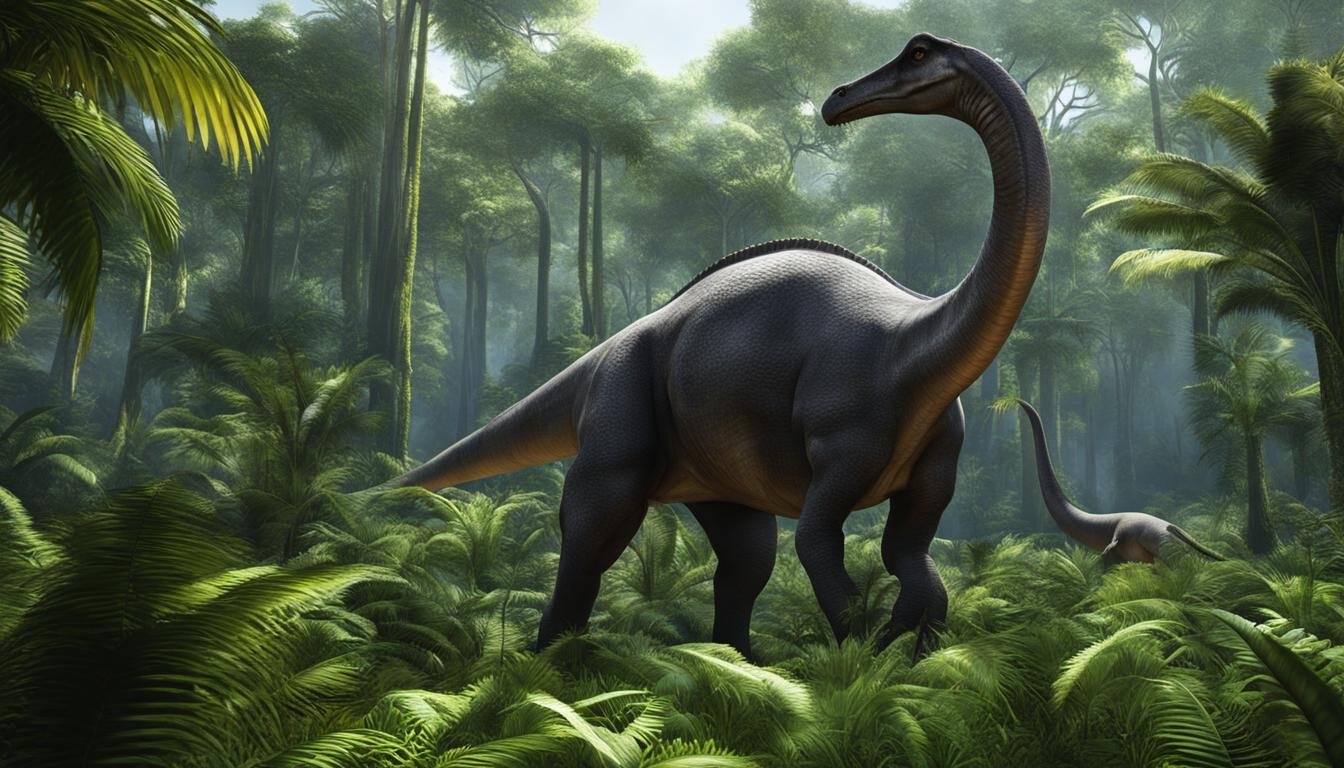Dinosaur physiology, a captivating field for paleontologists, offers insights into the life of these ancient giants through fossil evidence. A central debate is their thermoregulation, with new research suggesting dinosaurs might have been mesotherms, neither fully warm nor cold-blooded.
Understanding their growth rates, another key aspect, helps estimate their lifespan, although this remains a challenging area of study. Fossil anatomy, from bone structure to air-filled sacs, provides clues about their internal functioning, yet fully grasping these features in relation to their metabolism is an ongoing task.
As new discoveries emerge and technologies advance, our comprehension of dinosaur physiology, from thermoregulation to sensory abilities, continues to evolve, shedding light on these prehistoric enigmas.
Dinosaur Musculature and Locomotion
The study of dinosaur skeletons provides valuable insights into their musculature and locomotion. By examining the shape and connections of bones, paleontologists can reconstruct the positions of muscles, cartilage, and ligaments. This allows them to understand how different dinosaur species moved and interacted with their environment.
Scratches and wear patterns on teeth also give clues about dinosaur diet and feeding behavior. These dental features provide insights into whether a dinosaur was a carnivore, herbivore, or omnivore. Furthermore, modern technologies such as computed tomography (CT) scanning enable scientists to examine the internal anatomy of dinosaur fossils, revealing features that were previously inaccessible. For example, CT scans can show the shape of the brain and the presence of air-filled sacs in dinosaur bones.
| Dinosaur Musculature and Locomotion | Key Findings |
|---|---|
| Muscle Reconstruction | The study of dinosaur skeletons helps reconstruct the positions of muscles, cartilage, and ligaments, providing insights into locomotion and movement. |
| Dental Analysis | Scratches and wear patterns on teeth give clues about dinosaur diet and feeding behavior, indicating whether a dinosaur was a carnivore, herbivore, or omnivore. |
| Advancements in Technology | Modern techniques such as CT scanning allow scientists to examine the internal structure of dinosaur fossils, revealing previously inaccessible features like brain shape and air-filled sacs. |
“The study of dinosaur skeletons provides a window into the world of these ancient creatures. By understanding their musculature and locomotion, we can gain insights into how they moved and interacted with their environment.”
Overall, the study of dinosaur musculature and locomotion is a vital component of paleontological research. It allows scientists to reconstruct the movement patterns and behaviors of these fascinating prehistoric animals, providing a deeper understanding of their biology and ecology.
Dinosaur Thermoregulation and Metabolism
Understanding how dinosaurs regulated their body temperature and their metabolic rates is a topic of ongoing research and debate in the field of paleontology. The question of whether dinosaurs were warm-blooded (endothermic) or cold-blooded (ectothermic) has long fascinated scientists.
A study by biologist John Grady and colleagues proposes that dinosaurs were mesotherms, capable of some level of internal body temperature regulation. Mesothermy allows for a higher body temperature than the surrounding environment but not at a fixed point, providing a level of physiological flexibility. However, paleontologist Mike D’Emic criticizes this theory, pointing out flaws in the growth rate estimation that supports endothermic physiology.
While the debate continues, researchers use anatomical features of dinosaur fossils to gain insights into their thermoregulatory strategies. Accurately estimating growth rates and understanding how they relate to metabolism remains a challenge. The ongoing study of dinosaur thermoregulation and metabolism contributes to our understanding of how these fascinating creatures adapted to their ancient environments.
Dinosaur Thermoregulation: Endothermy vs. Ectothermy
The debate over dinosaur thermoregulation centers around whether dinosaurs were endothermic or ectothermic. Endothermic dinosaurs would have had the ability to generate their own body heat and maintain a constant internal temperature, similar to modern birds and mammals. Ectothermic dinosaurs, on the other hand, would rely on external sources of heat to regulate their body temperature, like modern reptiles.
The mesothermic theory suggests that dinosaurs fell somewhere in between, able to maintain a higher body temperature than their environment but not at a fixed point. This flexibility may have allowed dinosaurs to adapt to various environmental conditions throughout their lifetimes.
Metabolic Rates and Growth Patterns
Another aspect of dinosaur physiology being investigated is their metabolic rates and growth patterns. Endothermic animals typically have higher metabolic rates and faster growth rates compared to ectothermic animals.
Grady’s study proposes that dinosaurs had growth rates consistent with endothermic physiology. However, D’Emic’s criticism challenges this conclusion, highlighting flaws in growth rate estimation and suggesting that the evidence supports endothermic physiology.
Understanding dinosaur metabolism is crucial for reconstructing their ecological niche and how they adapted to their ancient environment. The ongoing study of dinosaur thermoregulation, metabolism, and growth patterns contributes to our understanding of the physiology and evolution of these remarkable creatures.
Dinosaur Circulatory and Respiratory Systems
The circulatory and respiratory systems of dinosaurs played crucial roles in their survival and ability to thrive in their prehistoric environments. By examining the skeletal structures of dinosaur fossils, paleontologists can gain insights into how these systems functioned.
Circulatory System
The circulatory system of dinosaurs included blood vessels that transported oxygen and nutrients throughout their bodies. The size and structure of these blood vessels can be inferred from the bone features observed in fossils. For example, large vascular canals in certain dinosaur bones indicate the presence of well-developed blood vessels. These blood vessels would have allowed efficient transportation of blood, promoting the oxygenation and nourishment of dinosaur tissues.
Respiratory System
The respiratory system of dinosaurs played a vital role in their ability to breathe and extract oxygen from the air. Fossil evidence suggests that dinosaurs had lungs similar to modern-day reptiles and birds. However, recent discoveries have revealed the presence of unique adaptations in some dinosaurs, such as the presence of air sacs. These air sacs would have facilitated efficient respiration and provided a means for maintaining a constant supply of oxygen to the muscles and other tissues.
| Dinosaur Circulatory System | Dinosaur Respiratory System |
|---|---|
| Dinosaur circulatory system included well-developed blood vessels. | Dinosaurs had lungs similar to reptiles and birds. |
| Large vascular canals observed in some dinosaur bones. | Air sacs discovered in certain dinosaur fossils. |
| Efficient transportation of oxygen and nutrients. | Facilitated efficient respiration and constant oxygen supply. |
Understanding the circulatory and respiratory systems of dinosaurs provides valuable insights into their physiology and how they adapted to their ancient environments. Further research and analysis of fossil evidence will continue to enhance our understanding of these fascinating prehistoric creatures.
Dinosaur Digestive System and Diet
The study of dinosaur teeth provides valuable insights into their diet and feeding habits. Different species of dinosaurs had distinct tooth structures that were adapted to their specific dietary needs. Some dinosaurs had large, sharp teeth designed for tearing meat and consuming flesh, indicating a carnivorous diet. These meat-eating dinosaurs, known as theropods, were at the top of the prehistoric food chain. On the other hand, herbivorous dinosaurs had flat, broad teeth that were ideal for grinding plant material. They consumed a variety of vegetation, including leaves, ferns, and other plant matter.
The digestive system of dinosaurs can be inferred from the size and structure of their bodies. The length and complexity of their intestines suggest that dinosaurs had a more elaborate digestive system compared to modern-day reptiles. Larger dinosaurs likely had multiple-chambered stomachs to ferment plant matter and extract nutrients. Additionally, some dinosaur fossils have been found with gastroliths, which are stones that were swallowed and held in the stomach to aid in digestion.
“The examination of dinosaur teeth can provide clues about their diet.”
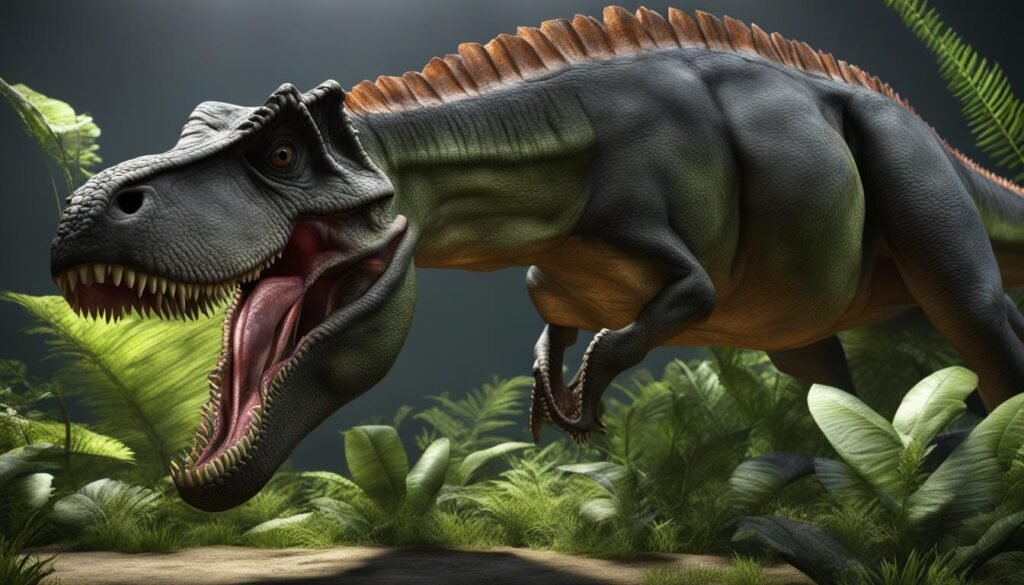
| Dinosaur | Feeding Type | Example |
|---|---|---|
| Theropods | Meat-eating (Carnivorous) | Tyrannosaurus rex |
| Sauropods | Plant-eating (Herbivorous) | Brachiosaurus |
By analyzing the fossilized gut contents and coprolites (fossilized feces) of dinosaurs, researchers can directly examine the plant or animal material that was consumed. This provides valuable evidence to support their dietary reconstructions. The study of dinosaur digestion and diet helps us understand their ecological roles and the complex interplay between different species in prehistoric ecosystems.
Dinosaur Sensory Organs
The study of dinosaur sensory organs provides valuable insights into how these ancient creatures experienced the world around them. By examining the shape and structure of dinosaur skulls and associated bones, paleontologists can make educated inferences about their vision, hearing, and olfaction. Large eye sockets suggest that some dinosaurs had keen eyesight, allowing them to detect prey or potential threats from a distance. The presence of specific features like cochlea and nasal cavities indicates that certain dinosaurs had well-developed hearing and olfactory abilities, enhancing their sensory perception and aiding in navigation and communication.
Comparative anatomy studies with modern-day birds and reptiles further inform our understanding of dinosaur sensory systems. Birds are descendants of dinosaurs and share many anatomical similarities, making them important references for understanding the sensory capabilities of their ancient relatives. For example, the shape of the skull and the arrangement of bones in birds can help paleontologists reconstruct the sensory organs of dinosaurs, providing insights into their ability to see, hear, and smell in their prehistoric environments.
“The study of dinosaur sensory organs allows us to envision how these magnificent creatures experienced their ancient world. By examining their skulls and comparing them to modern-day birds, we can gain a better understanding of their vision, hearing, and olfaction.”
While significant progress has been made in understanding dinosaur sensory systems, there is still much to learn. The intricate details of how these sensory organs functioned and the range of variation among different dinosaur species remain areas of ongoing research and debate. As technology advances and new fossil discoveries emerge, scientists will continue to unravel the mysteries of dinosaur senses, providing us with a more complete picture of these fascinating prehistoric creatures.
| Sensory Organ | Dinosaur Capabilities |
|---|---|
| Vision | Evidence suggests that some dinosaurs had keen eyesight, enabling them to detect movement and spot potential prey or predators. |
| Hearing | By studying the structure of skulls and associated bones, paleontologists infer that certain dinosaurs had well-developed hearing, allowing them to detect sounds and communicate with others of their species. |
| Olfaction | The presence of specific features in dinosaur skulls suggests that some species had a well-developed sense of smell, which would have played a crucial role in finding food, identifying mates, and detecting potential dangers in their environment. |
Advancements in Understanding Dinosaur Senses
Recent advancements in technology, such as high-resolution imaging techniques and three-dimensional modeling, have revolutionized our ability to study dinosaur sensory organs. Computed tomography (CT) scanning allows scientists to non-destructively examine the internal structures of dinosaur skulls, providing detailed information about the size and shape of sensory-related features. This technology has enabled paleontologists to create virtual reconstructions of sensory systems, enhancing our understanding of how dinosaurs interacted with their environment.
Additionally, the study of preserved soft tissues in dinosaur fossils has opened up new avenues of research. Soft tissues, such as brain tissue and sensory organs, are rarely preserved in the fossil record. However, in exceptional cases, the preservation of these delicate structures can provide direct insights into dinosaur sensory capabilities. These discoveries have shed light on the remarkable adaptations and sensory abilities of certain dinosaur species, challenging our preconceived notions and expanding our understanding of these ancient creatures.
- Advancements in technology, such as CT scanning, allow scientists to non-destructively examine the internal structures of dinosaur skulls.
- The study of preserved soft tissues in dinosaur fossils provides valuable direct insights into dinosaur sensory capabilities.
- Virtual reconstructions of sensory systems enhance our understanding of how dinosaurs interacted with their environment.
Dinosaur Growth Patterns and Reproductive Biology
The growth patterns and reproductive biology of dinosaurs provide valuable insights into their life histories and population dynamics. Paleontologists analyze growth rates, maturity, and the fossilized remains of eggs and nests to understand how dinosaurs reproduced and developed throughout their lives. By examining these factors, researchers can gain a better understanding of the reproductive success, reproductive seasons, and overall lifespan of different dinosaur species.
One of the key aspects of dinosaur growth patterns is the estimation of growth rates. By studying the growth rings in dinosaur bones, paleontologists can determine how fast these ancient creatures grew and reached maturity. This information helps in understanding the pace of development and the potential factors that influenced growth, such as environmental conditions and resource availability.
Additionally, the fossilized remains of dinosaur eggs and nests provide direct evidence of their reproductive strategies. By studying the size, shape, and arrangement of eggs, as well as the characteristics of nests, paleontologists can infer the incubation period, nesting behavior, and potential parental care exhibited by different dinosaur species. These findings shed light on the reproductive behaviors and strategies that dinosaurs employed to ensure the survival of their offspring.
| Dinosaur Species | Growth Rate (mm/year) | Maturity Age (years) |
|---|---|---|
| Tyrannosaurus rex | 198 | 20 |
| Triceratops | 34 | 12 |
| Stegosaurus | 45 | 10 |
Recent discoveries have provided fascinating insights into dinosaur reproductive biology. The discovery of nesting sites, containing thousands of dinosaur eggs, suggests that some species may have exhibited colonial nesting behaviors similar to modern-day seabirds. This finding challenges the notion of dinosaurs as solitary and provides evidence of complex reproductive behaviors.
Dinosaur Eggs and Nests
- The size and structure of dinosaur eggs indicate the size of the hatchlings and the potential nesting environment.
- The arrangement of eggs in nests can reveal whether dinosaurs exhibited brooding behaviors or left their eggs unattended.
- Analysis of fossilized embryos within eggs can provide insights into the developmental stages of dinosaurs before hatching.
Studying the growth patterns and reproductive biology of dinosaurs allows us to paint a more complete picture of these ancient creatures and their evolution. By examining growth rates, maturity ages, and the fossilized remains of eggs and nests, paleontologists can gain insights into how dinosaurs grew, reproduced, and contributed to the diversity of life on Earth during their time.
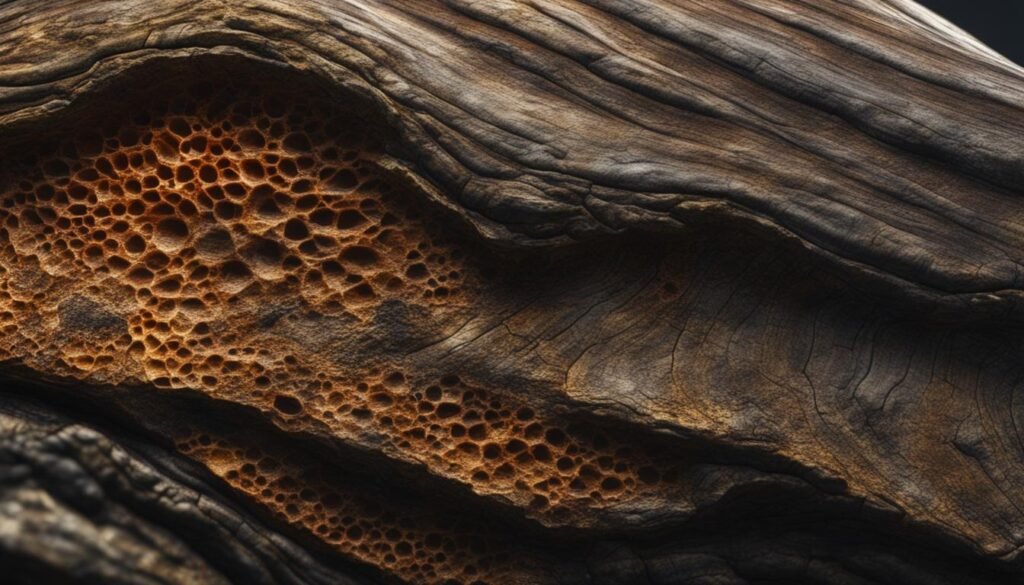
Dinosaur Skin and Scales, Feathers
The study of dinosaur skin and integumentary structures provides fascinating insights into these ancient creatures’ appearance and adaptations. Fossilized skin impressions, scales, and even evidence of feathers have been found in some dinosaur fossils, offering valuable clues about their external characteristics. Understanding the texture and composition of dinosaur skin helps us reconstruct their physical appearance and how they were protected against various environmental factors.
One notable discovery in recent years is the presence of feathers in certain dinosaur groups. This finding suggests an evolutionary link between dinosaurs and modern birds. Fossilized feathers have been found in various dinosaur species, such as Velociraptor and Anchiornis. These feathers likely served purposes ranging from insulation to communication and even flight. The presence of feathers challenges the traditional image of dinosaurs as scaly creatures and brings us closer to understanding the true diversity of their integumentary structures.

The diversity of dinosaur skin is further exemplified by the presence of scales in certain species. Some dinosaurs, like the armored Stegosaurus and the mighty Tyrannosaurus rex, had scales covering their bodies, providing protection and possibly aiding in thermoregulation. The texture and arrangement of these scales varied among different types of dinosaurs, revealing intricate details about their physical adaptations.
To gain a better understanding of dinosaur skin and scales, paleontologists have studied the preserved skin impressions and scales found in fossils. By meticulously analyzing these impressions, scientists can reconstruct the arrangement, texture, and even coloration of dinosaur skin. This information allows us to visualize how these creatures appeared millions of years ago and provides valuable insights into their evolution and adaptation to diverse environments.
To summarize, the study of dinosaur skin, scales, and feathers provides crucial information about these ancient creatures’ appearance, adaptations, and evolutionary relationships. Fossilized skin impressions and scales help us reconstruct the physical features of different dinosaur species and understand how they adapted to their environments. The discovery of feathers in certain dinosaur groups highlights the evolutionary connection between dinosaurs and birds, challenging traditional perceptions of dinosaur integument. Advances in paleontological research continue to uncover new insights into dinosaur skin and integumentary structures, painting a more detailed picture of these fascinating creatures that once roamed the Earth.
Dinosaur Skin and Scales Table
| Dinosaur Name | Integument Type | Examples |
|---|---|---|
| Tyrannosaurus rex | Scales | Large, bumpy scales covering the body |
| Stegosaurus | Scales | Small, overlapping scales creating an armor-like appearance |
| Anchiornis | Feathers | Downy feathers covering the body, possibly aiding in insulation and flight |
| Velociraptor | Feathers | Feathers on the arms, tail, and possibly the body, possibly aiding in communication and balance |
Dinosaur Immune and Neural Systems
Studying the immune and neural systems of dinosaurs is a challenging task due to the limited fossil evidence available. However, through the analysis of their skeletal structures, paleontologists have been able to gain some insights into these aspects of dinosaur physiology. The size and structure of the braincase can provide clues about the size and complexity of the dinosaur’s brain, which in turn may relate to their cognitive abilities. Comparative studies with modern-day relatives, such as birds and reptiles, also contribute to our understanding of the potential immune and neural systems of dinosaurs.
“The study of dinosaur physiology is a complex field, and the immune and neural systems are particularly difficult to investigate,” says paleontologist Dr. Jane Wilson. “However, by examining the structure of dinosaur brains and comparing them to living animals, we can make educated inferences about their cognitive capabilities.”
One key aspect of the neural system in dinosaurs is encephalization, which refers to the relative size of the brain in relation to body size. Recent research has shown that some dinosaur species had relatively large brains compared to their body size, suggesting a higher level of intelligence and adaptability. However, the exact functions and capabilities of these enlarged brains are still a subject of speculation and ongoing research.

Comparative Study: Dinosaur Brain Size
To gain a better understanding of the neural systems of dinosaurs, scientists have conducted comparative studies with modern-day animals. One such study compared the brain size of several dinosaur species to modern birds and reptiles. The results showed that certain dinosaur groups, such as the small theropods, had brain-to-body size ratios comparable to those of modern birds, suggesting similar cognitive abilities.
| Dinosaur Species | Brain Size (cm3) | Body Size (m) | Brain-to-Body Ratio |
|---|---|---|---|
| Velociraptor | 160 | 2 | 0.008 |
| Tyrannosaurus rex | 600 | 12 | 0.005 |
| Triceratops | 200 | 9 | 0.002 |
| Modern Sparrow | 1.5 | 0.02 | 0.075 |
| Modern Alligator | 3 | 4 | 0.00075 |
The table above provides a comparison of brain size and body size ratios for several dinosaur species and modern birds and reptiles. It is important to note that this comparison is based on limited data and should be interpreted with caution. Further research and the discovery of new fossil evidence will contribute to a more accurate understanding of dinosaur neural systems and their cognitive capabilities.
Dinosaur Vision, Hearing, and Olfaction
The sensory capabilities of dinosaurs, including vision, hearing, and olfaction, are subjects of ongoing research and speculation among paleontologists. While direct evidence is limited, the shape and structure of dinosaur skulls and associated bones provide some clues about their sensory organs. By studying the sensory systems of modern-day birds and reptiles, scientists can make educated inferences about the sensory abilities of dinosaurs.
Dinosaur skulls show a wide range of variations, suggesting different sensory adaptations among various species. For instance, large eye sockets indicate that some dinosaurs may have had keen eyesight, allowing them to detect prey or predators from a distance. Similarly, the presence of cochlea and nasal cavities suggests the development of hearing and olfactory abilities, respectively.
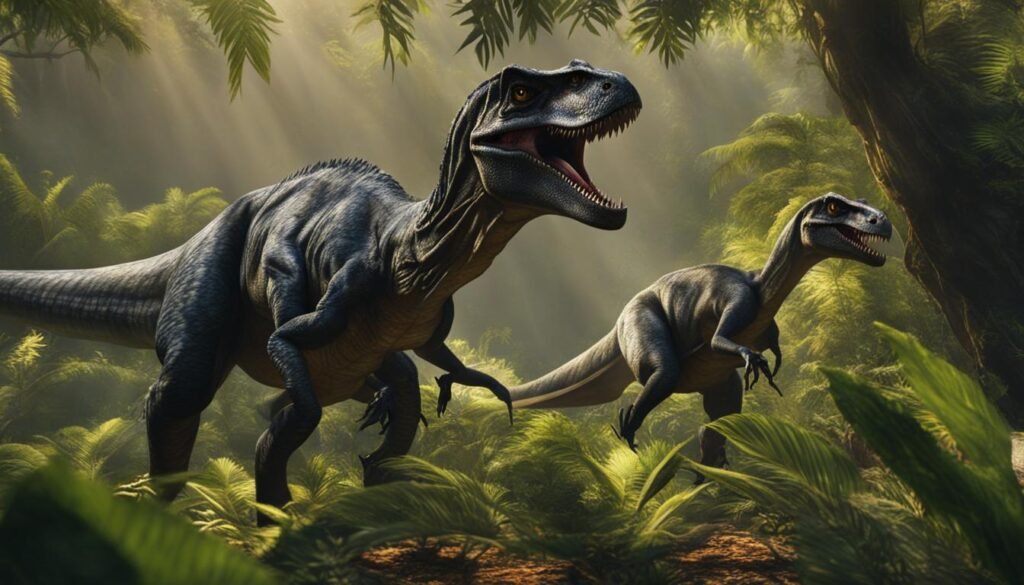
However, it is important to note that the specific sensory capabilities and range of variation among different dinosaur species are still areas of active research and debate. The limited fossil evidence and the absence of soft tissues make it challenging to reach definitive conclusions. Nonetheless, paleontologists continue to uncover new insights and develop sophisticated methods to understand how dinosaurs perceived the world around them.
Dinosaur Adaptations and Behavioral Ecology
Dinosaurs were a diverse group of animals that inhabited various environments and exhibited a wide range of adaptations and behaviors. These adaptations allowed them to thrive in their respective ecological niches and interact with their environment and each other. Understanding dinosaur adaptations and behavioral ecology provides valuable insights into how these ancient creatures lived and survived.
Dinosaur Adaptations
Dinosaurs had a variety of adaptations that allowed them to adapt to different environments and fulfill their ecological roles. These adaptations included specialized teeth, claws, and body shapes. For example, the long necks of sauropods allowed them to reach high vegetation, while the sharp teeth and claws of theropods enabled them to efficiently capture and consume prey. These adaptations were crucial for their survival and success in their respective habitats.
Behavioral Ecology
Dinosaur behavior was shaped by their ecological roles and interactions with other dinosaurs. Fossil evidence suggests that some dinosaurs exhibited complex social behaviors. Trackways and evidence of herding indicate that some species lived in groups and exhibited cooperative behavior. This social structure may have facilitated hunting, protection against predators, and resource sharing. The study of dinosaur behavior provides insights into their social dynamics and the complexity of their interactions.
| Dinosaur Behaviors | Description |
|---|---|
| Herding | Some dinosaur species lived in herds, which provided protection, enhanced hunting efficiency, and resource sharing. |
| Parental Care | Fossil evidence suggests that some dinosaurs exhibited parental care, including nest building and brooding of eggs. |
| Aggression | Intergroup competition and territorial disputes among dinosaurs may have led to displays of aggression and combat. |
| Mating Displays | Some dinosaurs likely engaged in elaborate mating displays to attract mates and establish dominance within their species. |
“Understanding dinosaur adaptations and behavioral ecology provides valuable insights into how these ancient creatures lived and survived.”
In summary, dinosaur adaptations and behavioral ecology are key factors in understanding how these ancient creatures thrived in their environments. The diverse adaptations of dinosaurs allowed them to occupy various ecological niches and fulfill different roles within their ecosystems. The study of dinosaur behavior provides valuable information about their social structures, mating rituals, and interactions with other dinosaurs. By analyzing these aspects of dinosaur life, paleontologists can piece together a more comprehensive understanding of these fascinating creatures and the world they inhabited.

Dinosaur Growth Patterns and Evolutionary Biology
The study of dinosaur growth patterns and evolutionary biology is crucial for understanding the diversity and evolutionary history of these ancient creatures. By analyzing fossil evidence and constructing phylogenetic trees, paleontologists can gain valuable insights into how different dinosaur species evolved over time, as well as the factors that contributed to their eventual extinction.
One of the key aspects of dinosaur growth patterns is the rate at which they reached maturity. By examining growth rings in dinosaur bones, scientists can estimate the age at which dinosaurs reached sexual maturity and gain insights into their overall lifespan. This information helps us understand the reproductive strategies and population dynamics of different dinosaur species.
Additionally, studying the evolutionary biology of dinosaurs allows us to explore the patterns of speciation and extinction that occurred throughout their existence. By analyzing the distribution of dinosaur species and their relationships to one another, paleontologists can uncover important clues about the ecological niches occupied by different dinosaurs and the environmental changes that influenced their evolution.
To illustrate the diversification and evolutionary relationships among dinosaurs, the table below showcases a simplified phylogenetic tree. Please note that this table is for illustrative purposes only and does not represent the full complexity and diversity of dinosaur evolution.
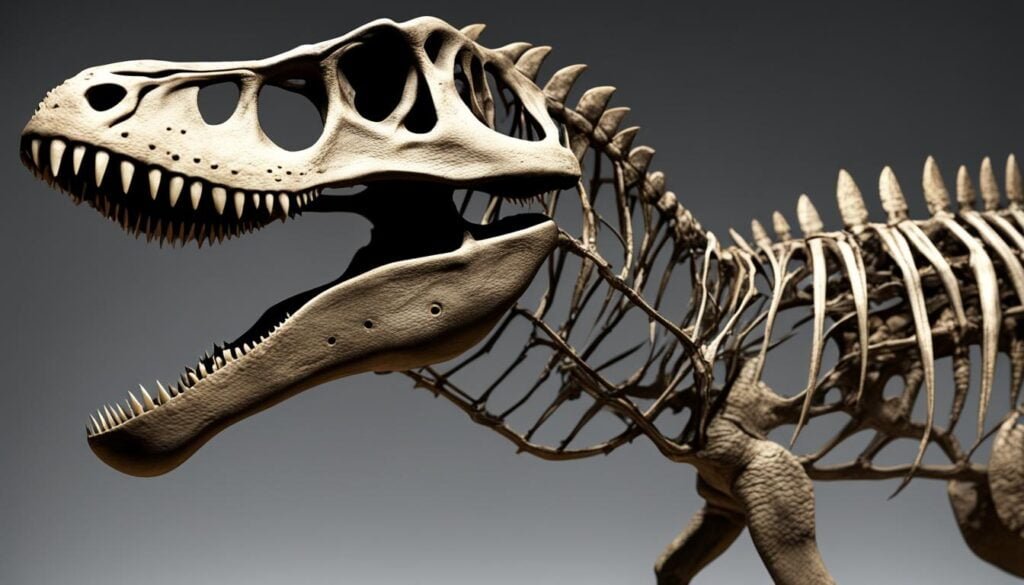
| Dinosaur Group | Representative Species | Time Period |
|---|---|---|
| Theropods | Tyrannosaurus rex | Late Cretaceous |
| Ornithopods | Hadrosaurus | Late Cretaceous |
| Sauropods | Apatosaurus | Late Jurassic |
| Thyreophorans | Stegosaurus | Late Jurassic |
This simplified phylogenetic tree highlights the major dinosaur groups and some representative species from different time periods. It demonstrates the diversification of dinosaurs throughout their evolutionary history and provides a glimpse into their incredible variety and adaptation to various ecological niches.
Conclusion
In the field of paleontology, the study of dinosaur physiology remains a subject of ongoing research and exploration. Scientists are constantly discovering new fossil evidence and utilizing advanced technologies to unravel the mysteries of these ancient creatures.
Dinosaur physiology encompasses a wide range of topics, including thermoregulation, metabolism, sensory capabilities, and more. While there is still debate and discussion surrounding these areas, researchers are making significant progress in understanding how dinosaurs lived and functioned.
Through careful analysis and interpretation of fossilized remains, paleontologists continue to shed light on the physiology of different dinosaur species. The information gathered from these studies helps build a more comprehensive picture of dinosaur life and provides valuable insights into their unique adaptations and behaviors.
Ongoing studies and research in the field of paleontology ensure that our knowledge of dinosaur physiology will continue to grow. By delving deeper into the intricacies of their biology, we gain a greater appreciation for these extraordinary creatures that once roamed the Earth.

